
The Severn Valley Railway is a standard gauge heritage railway in Shropshire and Worcestershire, England, named after the company that originally built the railway over which it now operates. The 16-mile (26 km) heritage line runs from Bridgnorth to Kidderminster, following the course of the River Severn along the Severn Valley for much of its route, and crossing the river on the historic Victoria Bridge.

Bridgnorth is a town and civil parish in Shropshire, England. The River Severn splits it into High Town and Low Town, the upper town on the right bank and the lower on the left bank of the River Severn. The population at the 2011 Census was 12,079.

Sir Gerald David Nunes Nabarro was a British businessman and Conservative Party politician who was an MP from 1950 until his death. Nabarro positioned himself on the right of the Conservative Party. Though he never left the backbenches, he was a comparatively high-profile political figure, owing in large part to his eccentric personal style.

The English county of Shropshire has a fairly large railway network, with 19 National Rail stations on various national lines; there are also a small number of heritage and freight lines, including the famous heritage Severn Valley Railway running along its eastern border with Worcestershire.
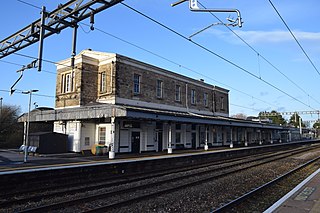
Swindon railway station is on the Great Western Main Line in South West England, serving the town of Swindon, Wiltshire. The station is 77 miles 23 chains down the line from the zero point at London Paddington and lies between Didcot Parkway and Chippenham. It is managed by Great Western Railway, which also operates all of the services from the station.

Nottingham Victoria railway station was a Great Central Railway and Great Northern Railway railway station in Nottingham, England. It was designed by the architect Albert Edward Lambert, who also designed the rebuild of the Nottingham Midland station.

Hampton Loade railway station is a station on the Severn Valley Railway heritage line, close to the hamlet of Hampton on the western bank of the River Severn; Hampton Loade itself is on the eastern bank, and can no longer be reached by the Hampton Loade Ferry across the river as this has ceased operation.

Burton-on-Trent railway station is a mainline railway station located in the town of Burton upon Trent, Staffordshire, England. It is owned by Network Rail and managed by East Midlands Railway, although only CrossCountry services call at this station.
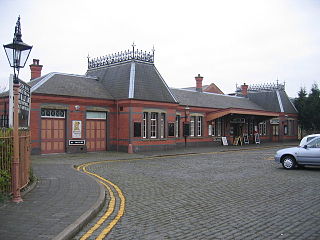
Kidderminster Town is a railway station situated in the town of Kidderminster, Worcestershire, England. It is operated by the Severn Valley Railway, a heritage line which runs from Kidderminster to Bridgnorth. The station was opened on 30 July 1984, was built in a late Victorian style, and shares its station approach and car park with the adjacent National Rail station.
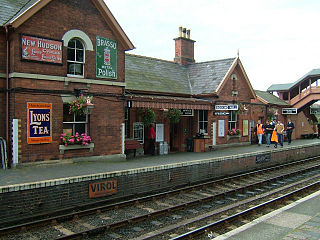
Bewdley railway station serves the town of Bewdley in Worcestershire, England. Until 2014, it was the administrative headquarters of the Severn Valley Railway, after which they were moved to Comberton Hill, Kidderminster. Bewdley is the principal intermediate station on the line.

Arley railway station is a station on the Severn Valley Railway heritage line in Worcestershire, situated just over the River Severn from the village of Upper Arley; a footbridge crosses the river to link the station to the village. The station is about 1⁄2 mile (0.8 km) north of Victoria Bridge, on which the SVR crosses the River Severn.

Highley railway station is a station on the Severn Valley Railway heritage line in Shropshire, near the west bank of the River Severn and just under a mile south-east of the village of Highley. Highley is the only staffed single-platform station on the line. Other stops with one platform are unstaffed halts.
The Severn Valley is a rural area of the West Midlands region of England, through which the River Severn runs and the Severn Valley Railway steam heritage line operates, starting at its northernmost point in Bridgnorth, Shropshire and running south for 16 miles (26 km) to Ribbesford, a few miles south of Bewdley, Worcestershire in the Wyre Forest.

Pershore railway station is a railway station serving both the town of Pershore and village of Pinvin in Worcestershire, England. The station is on a single-track section of the Cotswold Line. The station and all trains serving it are operated by Great Western Railway.

Eardington Halt, originally named Eardington, is a railway station on the Severn Valley Railway near Eardington, south of Bridgnorth, in Shropshire.
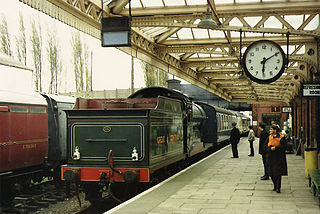
Loughborough Central Station is a railway station on the Great Central Railway and the Great Central Railway (preserved) serving Loughborough.

4930 Hagley Hall is a Great Western Railway, 4-6-0 Hall class locomotive, built in May 1929 at Swindon Works to a design by Charles Collett. It is one of eleven of this class that made it into preservation. The locomotive is named after Hagley Hall in Worcestershire.
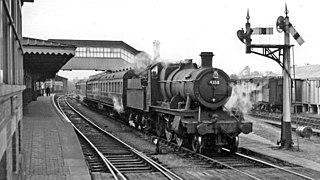
Ross-on-Wye railway station is a former junction railway station on the Hereford, Ross and Gloucester Railway constructed just to the north of the Herefordshire town of Ross-on-Wye. It was the terminus of the Ross and Monmouth Railway which joined the Hereford, Ross and Gloucester Railway just south of the station.

Market Drayton railway station served the town of Market Drayton in Shropshire, England, between 1863 and 1963. It was at the junction where three railway lines met: two of them, forming the Great Western Railway route between Wellington (Shropshire) and Crewe, were met by a line from Stoke-on-Trent on the North Staffordshire Railway.





















